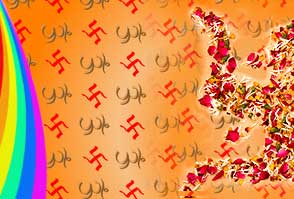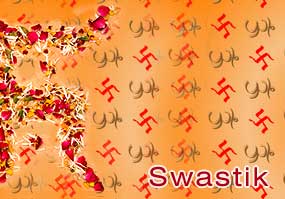Swastika symbol is popular worldwide; however, it
holds much more importance in India. The term has been derived from the
Sanskrit word "Svastika", which denotes affluence, happiness,
comfort, safety and good luck. It is considered to be a charm for
bringing good fortune and prosperity. Swastik cross consists of four
equal arms with each arm bending at the right angle. Well, people in
India are indeed aware of the Swastika symbol and its significance, but
very few know about its origin & history. To know about the history
of Swastika symbol, read on.
Indo Aryans, Greeks, Hittites and Celts made an extensive use of the
Swastika cross in the historic times. Swastika has been a sacred symbol
of Hindus since ages. There are millions of people who support as well
as advocate the use of Swastik; thereby popularizing it in such a manner
that it seems to have its relevance not just in the past but also in the
present society. Recent discoveries are evocative of the fact that
Swastika symbol made its presence felt even in the Indus Valley
Civilization.
Swastika is sometimes used in the form of a geometrical motif and
sometimes as a religious symbol. Almost all the cultures have adopted
Swastika then be it Asian, African, European or Native American. The
reason for using Swastika might differ from one culture to another, but
the fact is that Swastika has come in the forefront. The findings of
archaeological excavations suggest that the origin of Swastika can be
traced back to the Neolithic age. The Swastik sign was prevalent on
numerous ruins of the Khuzestan province of Iran. It is also found on
the "Vinca script" of the 5th millennium BC of Neolithic
Europe.
In the early Bronze Age, Swastik cross found its way in the pottery
designing. Its traces have also been found in the Iron Age. In the
ancient civilizations, Swastika did not really have a religious
significance, but it was used as a popular motif that was often used in
designing several articles of frequent use. In Zoroastrian Persia,
Swastika symbol represented the revolving sun, fire, perpetuity and
leisure. No mention has been made about Swastika in the Vedas. Its
religious significance was felt in India during the period of Mauryan
and Gupta Empire. Thus, Swastika has been in use since quite a long
period.
Swastika symbol is today used in most of the Dharmic religions. It is
also found in a number of Devanagari fonts. It is also used in the
modern Unicode. Most of the Hindu religious texts have the Swastika
symbol imprinted on them. It is increasingly finding its way in the
designing of wedding cards and decorations. In the year 1920, it became
popular as a Nazi symbol and thus became a very controversial motif. In
the Western countries, people are familiar with Swastik more as the
symbol of Nazis, rather than a religious symbol of Hindus.







